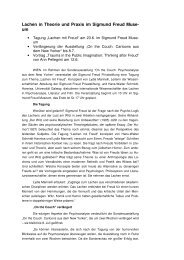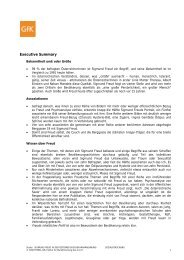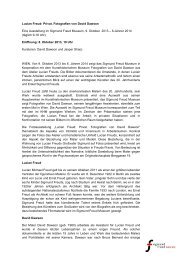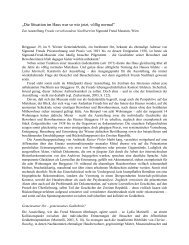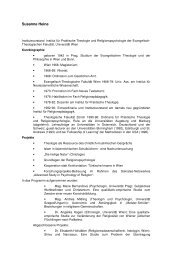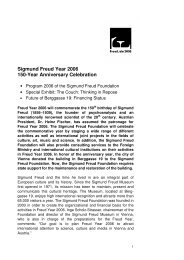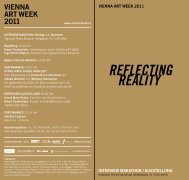Sigmund Freud-Museum | Newsletter - Sigmund Freud Museum Wien
Sigmund Freud-Museum | Newsletter - Sigmund Freud Museum Wien
Sigmund Freud-Museum | Newsletter - Sigmund Freud Museum Wien
You also want an ePaper? Increase the reach of your titles
YUMPU automatically turns print PDFs into web optimized ePapers that Google loves.
sherry turkle<br />
Sherry Turkle | Whither Psychoanalysis in a Computer Culture?*<br />
I. Psychoanalytic Culture and Computer Culture<br />
Over twenty years ago, as a new faculty member at MIT, I taught an introductory class on<br />
psychoanalytic theory. For one meeting, early in the semester, I had assigned <strong>Freud</strong>’s chapters on slips<br />
of the tongue from The Psychopathology of Everyday Life. I began class by reviewing <strong>Freud</strong>’s first<br />
example: the chairman of a parliamentary session begins the meeting by declaring it closed.1 <strong>Freud</strong>’s<br />
analysis centered on the possible reasons behind the chairman’s slip: he might be anxious about what<br />
the parliamentarians had on their agenda. <strong>Freud</strong>’s analysis turned on trying to uncover the hidden<br />
meaning behind the chairman’s remark. The theoretical effort was to understand his mixed emotions,<br />
his unconscious ambivalence.<br />
As I was talking to my class about the <strong>Freud</strong>ian notions of the unconscious and of ambivalence, one of<br />
the students, an undergraduate majoring in computer science, raised her hand to object. She was<br />
studying at the MIT Artificial Intelligence Laboratory, which was (and is) a place whose goal, in the<br />
words of one of its founders, Marvin Minsky, is to create “machines that did things that would be<br />
considered intelligent if done by people.” Work in the AI Lab began with the assumption that the<br />
mind, in Minsky’s terms, “was a meat machine,” best understood by analogizing its working to that of<br />
a computer program. It was from this perspective that my student objected to what she considered a<br />
tortured explanation for slips of the tongue. “In a <strong>Freud</strong>ian dictionary,” she began, “closed and open<br />
are far apart. In a Webster’s dictionary,” she continued, “they are as far apart as the listings for C and<br />
the listings for O. But in a computational dictionary – such as we have in the human mind – closed and<br />
open are designated by the same symbol, separated by a sign of opposition. Closed equals ‘minus’<br />
open. To substitute closed for open does not require the notion of ambivalence or conflict. When the<br />
substitution is made, a bit has been dropped. A minus sign has been lost. There has been a power<br />
surge. No problem.”<br />
With this brief comment, a <strong>Freud</strong>ian slip had been transformed into an information processing error.<br />
An explanation in terms of meaning had been replaced by a narrative of mechanistic causation. At the<br />
time, that transition from meaning to mechanism struck me as emblematic of a larger movement that<br />
might be taking place in psychological culture. Were we moving from a psychoanalytic to a computer<br />
culture, one that would not need such notions as ambivalence when it modeled the mind as a digital<br />
machine?2<br />
For me, that 1981 class was a turning point. The story of the relationship between the psychoanalytic<br />
and computer cultures moved to the center of my intellectual concerns. But the story of their<br />
relationship has been far more complex than the narrative of simple transition that suggested itself to<br />
me during the early 1980s. Here I shall argue the renewed relevance of a psychoanalytic discourse in<br />
digital culture. Indeed, I shall argue that this relevance is so profound as to suggest an occasion for a<br />
revitalization and renewal of psychoanalytic thinking.<br />
In my view, this contemporary relevance does not follow, as some might expect, from efforts to link<br />
psychoanalysis and computationally inspired neuroscience. Nor does it follow, as I once believed it<br />
would, from artificial intelligence and psychoanalysis finding structural or behavioral analogies in<br />
their respective objects of study.<br />
In my 1988 “Psychoanalysis and Artificial Intelligence: A New Alliance,”3 I suggested an opening for<br />
dialogue between these two traditions that had previously eyed each other with suspicion if not<br />
contempt. In my view, the opening occurred because of the ascendance of “connectionist” models of<br />
artificial intelligence. Connectionist descriptions of how mind was “emergent” from the interactions of<br />
agents had significant resonance with the way psychoanalytic object-relations theory talked about<br />
objects in a dynamic inner landscape. Both seemed to be describing what Minsky would have called a<br />
“society of mind.” Today, however, the elements within the computer culture that speak most directly<br />
to psychoanalysis are concrete rather than theoretical. Novel and evocative computational objects<br />
demand a depth psychology of our relationships with them. The computer culture needs<br />
psychoanalytic understandings to adequately confront our evolving relationships with a new world of



